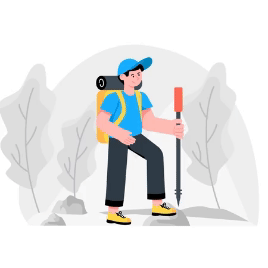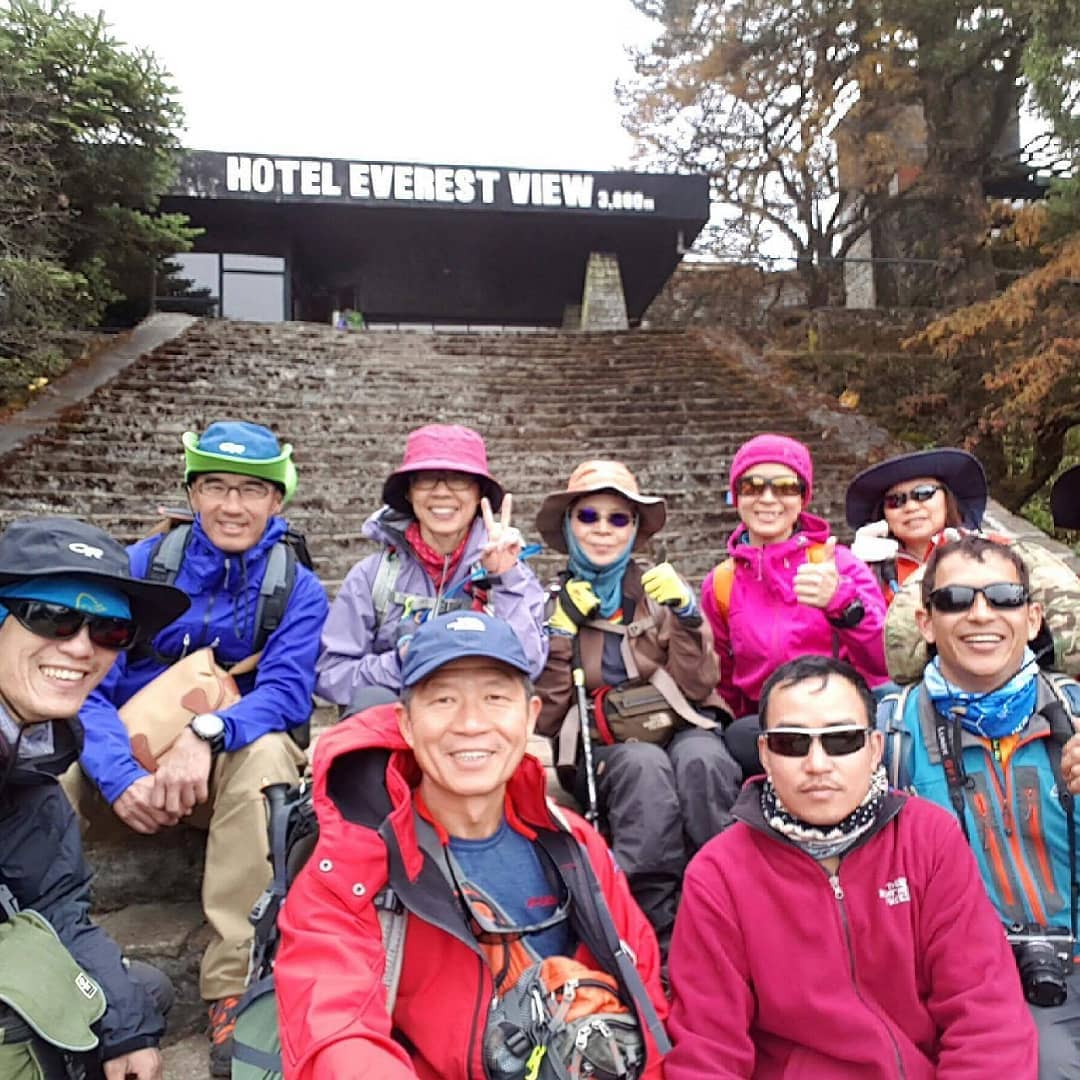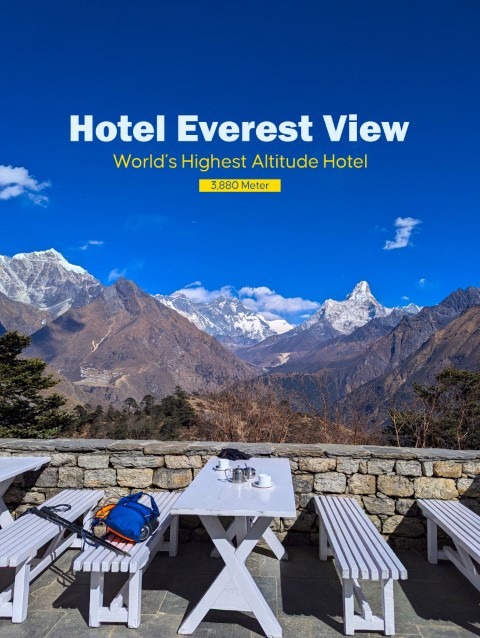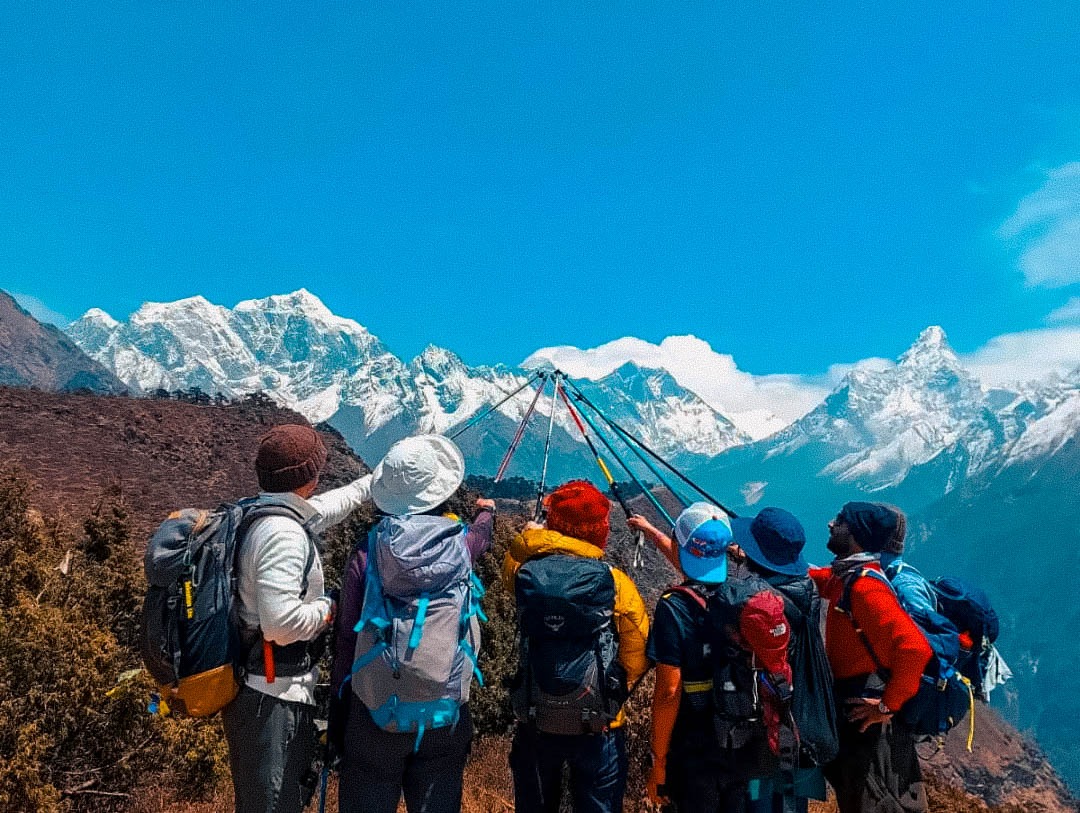

Hotel Everest View: Key Information at a Glance
| Category | Details |
| Location | 3,880m (12,730 ft), Sagarmatha National Park, Nepal |
| Altitude Record | Guinness World Record for Highest-Altitude Hotel |
| Rooms | 12 total (10 Standard, 2 Suites), with Everest views |
| Access | 2-hour trek from Namche or 45-minute helicopter from Kathmandu |
| Best Time to Visit | March - May & Sept - Nov (clear skies, mild temps) |
| Unique Features | Oxygen outlets in rooms, solar-powered showers, Sherpa staff |
| Dining | Local cuisine (Yak momo, Dal Bhat), limited by supply logistics |
| Activities | Khumjung Village, Tengboche Monastery, wildlife spotting |
| Sustainability | Solar power, waste flown to Kathmandu, supports local clinics/schools |
| Health Notes | Altitude sickness risk, on-call medic, Diamox recommended |
You open your eyes to a silent, frosted morning. The air is thin, reminding you that you’re sleeping higher than most birds dare to fly. Through the windows of your room, the first sunbeams shine on the surrounding whitescape of the Himalayas.
You are at Hotel Everest View, a 12-room lodge perched at 3,880 meters (12,730 feet) in the Khumbu Valley in Nepal, holding a Guinness World Record as the planet’s highest-altitude hotel.
Built in 1971 by Japanese architect Yoshinobu Kumagaya, the hotel was a major feat of logistics as every blanket, pane of glass and even the cutlery in your breakfast room was hauled up by porters or helicopters.
Today, it is a paradox of sorts, a bubble of luxury in the Himalayas, where WiFi signals and heated rooms coexist with yak caravans and Sherpa trails.
The hotel is at the edge of Syangboche, a ridge above Namche Bazaar. There are no roads here. To arrive, you either trek for two steep hours from Namche (passing prayer flags and dwarf junipers) or land via helicopter from Kathmandu in under an hour.
But staying here is a reward in teself. You have rooms that face the Everest massif, with Lhotse, Ama Dablam and Thamserku lined up beside it. The view isn’t just breathtaking, it is actually inescapable.
You will find yourself pausing mid-conversation, distracted by the way the light shifts on the mountains.
Hotel Everest View is pretty luxurious. And viewing it in the context of everything else in the Everest Region makes it all the more impressive. It offers:
The hotel’s 12 rooms are minimalist but well thought out with thick wool carpets, locally carved wooden furniture, and balconies just wide enough for two chairs and a pair of binoculars. It has a spacious dining hall where guests swap stories over dal bhat and hot ginger tea.
By 6 AM, the early risers gather on the terrace, wrapped in borrowed down jackets. Everest transforms from a shadow into a gold-hued monument. Someone whispers, “There it is,” though it has been there all along.
This moment is why people come. Not for the champagne, not for the Instagram shot (though everyone takes one), but for this very moment.
Later, over breakfast, you meet guests who trekked for days to get here and others who arrived by helicopter in designer sunglasses. Everyone there spends their first hour gawking out the windows like children.

You won’t find this place on any typical road map. Hotel Everest View sits at 3,880 meters (12,730 feet) on a ridge called Syangboche, just 2 kilometers uphill from Namche Bazaar, the bustling Sherpa capital of the Khumbu region.
| Key Details | Specification |
| Coordinates | 27°48'15.5"N 86°42'45.5"E |
| Altitude | 3,880 meters (12,730 feet) |
| Protected Area | Sagarmatha National Park (UNESCO World Heritage Site) |
| Distance from Everest Base Camp | 20km (12.4 miles) linearly; ~40km (25 miles) via trekking trails |
| Nearest Settlement | Namche Bazaar (2km downhill, 1-2 hour hike) |
| Notable Peaks in View | Everest (8,848m), Lhotse (8,516m), Ama Dablam (6,812m), Thamserku (6,608m) |
Your journey starts in Kathmandu. Then,
1) Morning flight to Lukla (2,860m): A 30-35(approx) minute ride in a 16-seat Twin Otter plane, where the pilots move through Himalayan valleys. The landing at Tenzing-Hillary Airport is a jolt of adrenaline, the runway slopes upward at 12 degrees to help planes stop.
2) Trek to Phakding (2,610m): 3 hours downhill, crossing suspension bridges draped with prayer flags over the Dudh Koshi River.
3) Ascend to Namche Bazaar (3,440m): A 6-hour trek, including the Namche Hill.
4) Final push to Hotel Everest View: From Namche, it’s a 2-hour uphill hike (400m elevation gain) on a rocky trail with pine and juniper forest around. The last 20 minutes are the easiest, you will experience a 360 degree view from this point.
Why trek?
Acclimatization: The slow ascent reduces altitude sickness risk.
Cultural immersion: You’ll pass Sherpa villages, mani walls (stone tablets carved with Buddhist prayers), and teahouses where locals drink butter tea.
Cost: (1,000$−1,800$) (approx) for a guided trek (flights, permits, lodging included) Vs. $4,000+(approx) for a private helicopter.
For those short on time or unable to trek:
1) Departure: A 5-seater helicopter lifts off from Kathmandu at dawn, skimming past terraced hillsides into the high Himalayas.
2) Scenic route: The pilot banks left to give you a 10-minute hover at Everest Base Camp, then flies over the Khumbu Icefall.
3) Landing at Syangboche: The helipad is a dirt clearing 200m below the hotel. Staff meet you with oxygen cans and hot towels.
Details matter:
Baggage limit: Around 5 kg per person, pack like you’re going to the moon
Best seats: Right side for Everest views on approach
Trade-offs:
No acclimatization: You’ll feel the altitude immediately (headaches are common).
Weather risks: Flights get delayed regularly by clouds or wind.
| Details | Specification |
| Total Rooms | 12 Deluxe Rooms |
| Bed Heating | Electric blankets (12V DC power) |
| Oxygen System | 2L/min flow rate, 60 psi pipeline |
| Water Pressure | 1.2 GPM (gravity-fed from 5,000L rooftop tank) |
| Construction | Stone walls (40cm thick), Japanese earthquake-resistant timber frame |
You step into your room and the first thing you notice is the silence. No traffic, no elevators, just the occasional whistle of wind against the double-glazed windows. Then, the view. A floor-to-ceiling sliding glass door frames Everest; its summit glows pink in the late afternoon light.
This is one of only 12 rooms in the hotel, each designed for a single purpose, which is to make you forget you are sleeping higher than Japan’s Mount Fuji.
Room Types and Layouts
All rooms face due north as architect Yoshinobu Kumagaya positioned them to ensure uninterrupted Everest views from every bed.
The Science of Sleeping at Altitude
Oxygen Enrichment: The hotel pumps 2-3% extra oxygen into common areas (dining room, lounge), but rooms rely on personal outlets. Guests report less headache fatigue compared to teahouses.
Acoustics: Walls are 20cm thick stone, no noise from neighbors, just occasional yak bells from the valley below.
Room Rates and Booking Nuances (Updated June 2025)
| Room Type | Price Range (Per Night) | Inclusions | Booking Tip |
| Deluxe Suite |
| Bed and Breakfast Plan | Book 6+ months ahead for October (Note: Early Bookings Recommended for Peak Season) |
Every detail reflects local pragmatism and the local culture. You will see things like:
Note: Common dining hall with a Chimney, Souvenir for shopping for local handicrafts.

Your First Meal of the Day in the Everest Region
The dining room is alive with energy early in the morning as staff light yak butter candles to take the edge off the morning chill. You are handed a menu, a single laminated sheet, because choices are limited when every ingredient arrives via helicopter or porter.
The staples are:
You sip black tea sweetened with sea buckthorn jam (vitamin C prevents scurvy at altitude) while watching the sunrise ignite Everest’s summit. The German couple at the next table, whose oxygen meters read 88%, debates whether to hike to Khumjung or rest.
Lunch Munchies
It’s noon. The dining room empties as trekkers depart for Khunde. You can order:
The kitchen runs on two propane burners and a wood-fired oven salvaged from a 1980s Japanese expedition.
Dinner Under the Stars
The night’s menu includes:
Yak momo: Dumplings with meat from a herd grazing at 4,200m (chewier than beef)
Thukpa: Noodle soup with dried morels foraged near Tengboche
Pan-fried trout: Caught in the Imja Khola (high-altitude fish have more fat)
Sea buckthorn sorbet: Sour berries picked below Namche, frozen with glacier ice
Raksi: Local millet liquor (served warm, alcohol hits harder at altitude)
A Belgian mountaineer at the bar insists on paying for his oxygen cocktail (vodka, lime, O2 bubbled through a medical mask). The bartender obliges because, well, he has seen stranger requests.
Distance from Hotel Everest View: 2km (20 min downhill, 40 min return uphill)
A) Key Sites:
Khumjung Monastery: Houses the purported ‘Yeti scalp’ (some say is a preserved Himalayan serow hide). $2 entry fee funds monastery upkeep.
Hillary School: Founded in 1961 by Sir Edmund Hillary. Peek into classrooms where kids learn in Nepali and English.
Traditional Sherpa Houses: A few families still live in stone homes with carved wooden mantles displaying Buddhist motifs.
B) Wildlife Spotting:
Danphe (Himalayan Monal): Nepal’s national bird. Best seen at dawn near the Syangboche helipad (iridescent plumage flashes in low light).
Musk Deer: Rare but occasionally spotted in the fir forests below Khumjung.
Pro Tip: Stop at Namche Bakery on the way back for apple pie, baked at 3,440m, it’s denser but satisfying.
Distance from Hotel Everest View: 1.5km (30 min steep descent, 1 hr return climb)
Notable Stops:
Sherpa Museum: Displays historic climbing gear and explains Sherpa culture (entry: $3).
Saturday Market: Vendors sell Tibetan spices, yak cheese, and counterfeit North Face gear.
Namche Gompa: A quiet monastery with 3-hour prayer sessions at 6 AM and 3 PM.
Distance from Hotel Everest View: 12km (7- 8 hrs round trip)
Route: Descend to Phunki Tenga (3,250m), then climb 600m to Tengboche.
Views: Direct sightlines to Ama Dablam (6,812m), Everest (8,848m), and Nuptse (7,861m).
Other Details:
Horse Option: $150(Approx) per day per camp for a local pony (handled by Sherpa guides) . Not recommended for downhill, horses struggle on the return’s steep, rocky sections.
Mani Rimdu Festival: If visiting in November, expect masked dances and butter sculpture displays.
Altitude Caution: The 1,200m elevation change risks AMS so carry medication and hydrate aggressively.
Distance from Hotel Everest View: 8km (6–7 hrs round-trip)
Rewards: 360° views of Thamserku (6,608m), Kangtega (6,782m), and the Gokyo Valley.
Hidden Gem: The abandoned tea house at the summit serves black tea with wild honey (when the owner is present).
Pro Tip: The trail crosses glacial moraines; watch for loose shale underfoot.
Distance from Hotel Everest View: 5km (6 hrs round-trip)
Terrain: Rocky switchbacks with no technical climbing required.
Solitude: Unlike crowded Kala Patthar, you’ll likely have the summit to yourself.
Helicopter Dust: Syangboche’s helipad kicks up debris, so cover your camera lens during takeoffs.
Trail Etiquette: Yaks have the right of way. Step to the uphill side to avoid being nudged off the path.
Battery Drain: Cold saps phone charge, so keep your device inside your jacket when not in use.
| Activity | Elevation Change | Risk Factor |
| Khumjung | -100m/+240m | Low |
| Namche | -400m/+400m | Moderate (return climb) |
| Tengboche | -600m/+1,200m | High (AMS risk) |
| Khunde Peak | +320m | Moderate (wind exposure) |
Altitude and Health Considerations at Hotel Everest View
| Metric | HEV Conditions | Sea Level Equivalent |
| Oxygen | 12.7% of air | 20.9% of air |
| Boiling Point | 82°C (180°F) | 100°C (212°F) |
| UV Index | 8-10 (extreme) | 3-6 (moderate) |
| Dehydration Rate | 1.5L water lost/hour hiking | 0.5L/hour |
1. Blood Chemistry Shifts
2. The 3 Most Common Symptoms
| Symptom | Cause | Action |
| Headache | Cerebral vasodilation | Drink 1 L of water + take 250mg of acetazolamide |
| Nausea | Gut hypoxia | Sip ginger tea, eat bland carbs (toast, rice) |
| Insomnia | Periodic breathing | Sleep at a 30° incline, use nasal strips |

Oxygen Outlets: Every room has 2L/min flow meters (like hospital walls). Use 1 hour pre-sleep if SpO₂ <88%.
Pulse Oximeters: Free loaners at reception (return by 9 AM).
On-Call Medic: A Khunde Clinic doctor is reachable via hotel radio (response time: 90 mins).
The Acclimatization Rules
For Trekkers (5+ Day Ascent)
For Helicopter Arrivals (Direct to 3,880m)
Hotel Everest View operates with all Sherpa staff from Khumjung and Khunde villages, directly supporting local families. The hotel actively preserves the endangered Sherpa language through trilingual signage (English/Nepali/Sherpa) and staff training programs.
Hotel Everest View partners with the Namche Women's Cooperative to sell handwoven blankets. The hotel funds Sherpa language classes for younger staff to combat cultural erosion.
While Hotel Everest View enforces 20kg weight limits for its porters, others on the Everest trails carry up to 50kg. The hotel's 8 daily helicopter flights disrupt wildlife, particularly Himalayan monal breeding grounds.
To mitigate this, Hotel Everest View funds alternative energy projects in Khumjung, reducing reliance on fossil fuels.
This model proves luxury tourism can ethically coexist with Sherpa traditions and Himalayan ecosystems when operations are transparent, accountable, and locally rooted. No embellishments - just measurable impact.
Key Takeaways for Responsible Travelers:
By choosing Hotel Everest View, travelers participate in a genuinely sustainable tourism model that benefits both visitors and the Khumbu community.
Hotel Everest View is a model for responsible tourism in one of the world's most fragile environments. From supporting Sherpa communities to pioneering eco-friendly practices, every aspect of the hotel's operations considers its impact on the Khumbu region.
The hotel goes beyond typical tourism by directly investing in Sherpa villages. A portion of every stay funds education at the Khumjung School and medical supplies for the Khunde Clinic. Staff are hired exclusively from nearby villages, paying above-average wages to ensure tourism benefits those who call the Himalayas home.
At this altitude, every resource matters. The hotel uses solar power whenever possible and strict water conservation systems to minimize waste. Guests participate by using refillable water bottles and following energy-saving guidelines during their stay.
The Himalayas are home to rare species like the Himalayan monal and musk deer. Hotel Everest View enforces helicopter flight restrictions during key wildlife hours and supports efforts to monitor local animal populations.
Tourism shouldn't erase traditions. The hotel:
Sustainable Tourism Challenges
Even with these efforts, some challenges remain:
The best months are March-May and September-November, when skies are clearest and temperatures hover between 5°C (41°F) and -10°C (14°F) at night.
Pro Tip: Book 6 months ahead for October, when Everest visibility peaks.
Clothing:
Gear:
Health Essentials:
Leave Behind:
Booking Smart
1) Room Selection
2) Transport:
3) Permits:
Health and Safety
Before You Go:
Hotel Everest View offers something no other property can: the chance to sleep in the shadow of Everest with minimal physical exertion. This is where every modern comfort has been adapted for high-altitude survival.
The experience rewards those seeking authentic Himalayan immersion over pampering, with cultural encounters most Everest trekkers miss by rushing to base camp.
The challenges are manageable for most. At 3,880 meters, your body will remind you constantly of the elevation through things like shortness of breath while climbing stairs, vivid dreams caused by oxygen deprivation and the dry air that chaps lips within hours.
Yet these very discomforts make the Everest sunrise views more earned. Unlike mountain lodges where backpackers cram into dormitories, the hotel provides private spaces to process the grandeur outside your window.
This experience best suits discerning adventurers, those who appreciate that hot showers and WiFi come with ecological costs at this altitude, and who derive satisfaction from participating in the hotel's sustainability efforts.
It's ideal for photographers needing extended time to capture perfect Himalayan light, or couples wanting to celebrate milestones somewhere profoundly unique.
Not every traveler will find it worthwhile. Those expecting typical resort amenities may balk at the minimalist rooms, while budget-conscious visitors might prefer teahouse trekking.
However, for anyone who's dreamed of Everest but lacks the time or stamina for a full trek, Hotel Everest View delivers the essence of the Himalayas: the silence of high places, the warmth of Sherpa hospitality, and humbling proximity to the world's tallest peak, with unprecedented accessibility.
At Trek Me Nepal, we thoughtfully include a stop at Hotel Everest View in many of our Everest Base Camp (EBC) trekking packages. We believe this place bridges luxury and authenticity in a way that perfectly complements the trekking experience.
Whether you're embarking on the full journey to Base Camp or choosing a shorter high-altitude adventure, our EBC packages are designed to give you not just a route but a story. And that story often begins with a morning coffee overlooking Everest from the world’s highest hotel.
Let us guide you to that moment. Explore our Everest Base Camp trek options and discover how Trek Me Nepal brings the spirit of the Himalayas to life.
Trek Me Nepal Archives
Check out recent travel trends and news by Trek me Nepal
More Reasons Why Travellers Trust Us